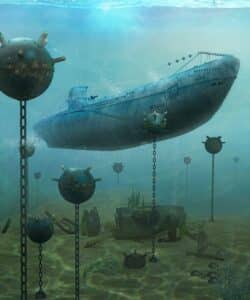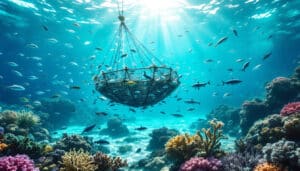“`html
Personal data and their use are at the heart of current concerns. Understanding how your information is used is essential to protect your privacy. Browsing the web involves a complex relationship with tracking and personalization technologies.
Cookies and associated data help to provide and maintain essential services. They also contribute to detecting outages and protecting against spam, fraud, and abuse. By measuring public engagement and site statistics, we better understand how our services are used to improve quality. You have the option to accept or reject the use of these tools according to your preferences.
Table of Contents
ToggleThe challenges of Trump’s strategy to limit China’s maritime influence
For several years, the rivalry between the United States and China in the maritime domain has intensified. Under President Donald Trump, the United States undertook various initiatives aimed at reducing China’s growing influence in the South China Sea and beyond. However, this attempt could extend over several decades due to various complex factors.
What were Trump’s main efforts to counter Chinese maritime influence?
The Trump administration adopted a multifaceted approach to limit China’s maritime expansion. Key measures included strengthening regional alliances, promoting new military and economic technologies, and imposing targeted sanctions. For example, the United States increased its naval presence in the Pacific, fostering collaboration with nations such as Japan, Australia, and the Philippines. Moreover, initiatives like maritime digitization in Australia and Singapore illustrate U.S. efforts to encourage sustainable and technologically advanced maritime practices among its allies, thereby strengthening a coalition against China.
What are the main obstacles to reducing China’s maritime influence?
Several factors complicate the task for the United States in its attempt to curb Chinese expansion. First, China’s massive investment in its navy and port infrastructure has created a strong foundation for its maritime influence. Projects like oceanic biodiversity demonstrate China’s commitment to marine sustainability, which strengthens its position on the international stage. Next, the global dependence on Chinese maritime trade, particularly in technological and manufacturing sectors, makes direct confrontation economically detrimental for many nations.
How long might it take to see the results of this anti-Chinese strategy?
Given the depth of Chinese influence and the complexity of geopolitical issues, it is realistic to anticipate that reducing this influence could take several decades. China shows no signs of slowing down in its maritime ambitions, continually investing in key sectors such as green technologies and digitization. Initiatives like carbon-neutral ammonia for maritime transport demonstrate China’s continuous innovation in crucial areas that enhance its maritime competitiveness.
What role does sustainability play in this maritime competition?
Sustainability has become a central pillar of the maritime competition between the United States and China. As both nations invest heavily in environmentally friendly technologies, they seek to establish standards that could dominate the global maritime industry. For example, China’s efforts to develop a blue economy show a willingness to combine economic growth with ecological preservation, thereby creating an attractive model for other countries. The United States, for its part, encourages similar initiatives among its allies, seeking to create a contrast with Chinese approaches and to position American values as international standards.
How do international alliances influence this dynamic?
International alliances play a crucial role in the United States’ attempt to counter Chinese influence. By strengthening ties with key partners in the Asia-Pacific, Europe, and Africa, the United States can create a united front against Chinese ambitions. Collaborations such as maritime news from Cyprus highlight the importance of strategic partnerships to promote common interests and counter Chinese initiatives. Furthermore, these alliances facilitate technology sharing, military coordination, and the promotion of international standards that favor balanced competition.
What are the economic impacts of this maritime rivalry?
The maritime competition between the United States and China has profound repercussions on the global economy. International supply chains are directly affected, with transport costs, logistical delays, and sourcing choices often influenced by geopolitical relations. Moreover, investments in maritime infrastructure such as ports and trade routes shape future trade flows. For example, maritime digitization in Australia and Singapore shows how technological innovation can attract investments and reshape regional economic dynamics, thereby influencing competition among major powers.
What are the security issues related to this struggle for influence?
Maritime security is at the heart of the rivalry between the United States and China. Controlling strategic maritime routes such as the Strait of Malacca or Atlantic waterways offers significant economic and military advantages. The United States seeks to maintain freedom of navigation and uphold the territorial rights of allied nations in the face of Chinese claims. Chinese investments in naval bases and energy routes enhance their ability to project power, compelling the United States to deploy considerable resources to preserve its influence and ensure the security of global maritime routes.
How does technology influence this maritime competition?
Technology is an essential lever in the maritime competition between the United States and China. Innovations in artificial intelligence, maritime surveillance, and green technologies enhance the presence and efficiency of naval forces. For example, initiatives for carbon-neutral ammonia for maritime transport illustrate how technological advances can transform maritime practices, reducing carbon footprint while increasing economic efficiency. Furthermore, the digitization of maritime operations allows for better fleet management, enhanced coordination among allies, and quicker responsiveness to emerging threats.
What are the projections for the future of this maritime rivalry?
In the future, the maritime rivalry between the United States and China is likely to intensify, with a continuing race for innovation and expansion of naval capabilities. The coming decades may see increased investments in research and development, a consolidation of international alliances, and a redefinition of maritime governance standards. Initiatives such as the development of the blue economy in Africa underscore the growing importance of emerging regions in this competition, offering both China and the United States new opportunities to extend their influence. However, the complexity of economic, security, and environmental issues suggests that this competition could continue long-term, requiring adaptive strategies and strengthened international cooperation to navigate these tumultuous waters.
What lessons can be learned from this rivalry for global maritime actors?
The competition between the United States and China offers valuable lessons for other global maritime actors. It demonstrates the importance of technological innovation, environmental sustainability, and international cooperation in building sustainable maritime influence. Countries looking to strengthen their position should invest in emerging technologies, promote environmentally friendly maritime practices, and forge strategic alliances based on common interests. Furthermore, the management of marine resources and the preservation of biodiversity, as highlighted by oceanic biodiversity, are essential for ensuring balanced economic growth and long-term geopolitical stability.
How can public policies adapt to this complex maritime reality?
Governments need to develop flexible and innovative public policies to respond to the changing dynamics of maritime competition. This includes strengthening educational and research capacities in maritime technologies, promoting public-private partnerships for developing sustainable infrastructure, and establishing regulatory frameworks that favor international cooperation. For example, maritime news from Cyprus illustrates how local policies can be integrated into a global strategy to enhance the resilience and competitiveness of nations facing global challenges. Additionally, policies must encourage adaptation to environmental and economic changes, ensuring a coherent and effective response to emerging threats.
What are the social impacts of this maritime rivalry?
Beyond economic and security implications, the maritime rivalry between the United States and China has significant social repercussions. Communities dependent on maritime industries, such as fishing, transportation, and scientific research, are directly affected by fluctuations in investments and maritime policies. Additionally, geopolitical tensions can lead to economic instability, impacting the well-being of local populations. It is therefore crucial to promote strategies that not only strengthen national influence but also support maritime communities and foster inclusive and sustainable growth.
How can international cooperation mitigate maritime tensions?
International cooperation is essential to mitigate maritime tensions and promote equitable maritime governance. By working together on common projects, such as biodiversity protection, development of green technologies, and maritime route security, nations can build bridges rather than walls. Collaborative initiatives, inspired by examples like digitization initiatives in Australia and Singapore, allow the sharing of resources, knowledge, and best practices, facilitating a harmonized approach to global maritime challenges. Moreover, active participation in international organizations such as the International Maritime Organization (IMO) can help establish common standards and peacefully resolve disputes.








